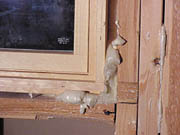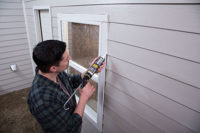

Come to think of it, we’ve just created a pretty good barrier wall too, just like EIFS.
The problems start when we add necessary requirements such as ventilation, egress, size, style types, cladding options and glazing types. With every manufacturing process, material change, hardware selection and feature, there’s potential for a future leak. Field installation can also contribute to unseen damage.
The window industry has several representative associations. Together, some industry groups developed a voluntary standard for window performance that was adapted by the new International Building Code (ANSI/AAMA/NWWDA 101/I.S.2.97). The new requirement is beneficial for improving the performance of windows, but I’m not too worried about visible leaks. It’s the ones you don’t see that cause the problems and get behind my siding.

Traditional thinking
The past can be a great teacher, but it can also hold you back. In the old days, some windows were flashed while others were installed without any flashing at all. Properly designed, both methods can stand the test of time.EIFS manufacturers have adapted the pan flashing and brought it to a new level of complexity. Peruse any manufacturer’s catalog and you’ll find the humble pan flashing, turned-up edges and all. To my thinking, these pan flashings must help spread the liability by inviting another trade to make the coordination more complicated. Even some new industry details show how to hide your flashing behind the system awhile, then run it out below a trim piece. Let go of the past!
I guess in the good old days, craftsmen happily worked together in this coordinated construction dance. Construction drawings were meticulously drawn, window opening sizes were always consistent, materials always arrived on time, and the details were perfect. I’ve always wanted to visit that job site.

Progressive thinking
EIFS is an excellent barrier wall. What if we changed our thinking from a barrier wall with breaks at penetrations to a continuous-water-barrier approach? Wouldn’t we think about the details differently? While we’re at it, we could eliminate backwrapping as much as possible and reduce the impossible coordination between trades. The water resistance of the entire wall is improved.In the process of revising all the system details to create a new product recently, we at Master Wall began to get very familiar with all the penetrations. It’s staggering to think that EIFS details really haven’t changed much in 20 years while windows and doors have clearly evolved. Never before have we had so many types of windows butting against our system.
The thinking is simple. If a window or door leaks, do what it takes to make it not leak.

Window inspection and maintenance
Did you know that windows and doors require annual maintenance? These are generally visual inspections of glass, window joints and sealant inspections. Since manufacturing processes are seldom perfect and installers may not use the best of care, it is beneficial to perform a thorough repair and maintenance procedure on all window installations. (See sidebar)
From a practical-use standpoint, maintenance is the equalizer between selecting a quality window, and a lower-cost version. You’ll clearly spend more time fixing a low-end window with several pieces and finger-jointed trim than a quality-clad unit with sealant oozing out of all the joints. Pay now or pay later—the choice is yours.
Secondary protection
Technology may be our greatest friend as long as we don’t make it too complicated. Sill pans seem like the old-fashioned way of protecting the sill, but still require complicated coordination between trades. Peel-and-stick tapes seem to work well for drainage systems, but are impractical for a barrier-wall situation.Perhaps something that is technologically sophisticated without being technically challenging is the solution. Wind Lock Foam-2-Foam Adhesive and Illbruck Universal Sealant—Gun Grade is a practical answer. These are professional-grade expanding polyurethane foam sealants designed specifically for sealing around windows and doors. Spray polyurethane is used as a roofing material, so protecting a window sill shouldn’t be a problem.
Follow the recommended technique for installation around most of the perimeter, keeping the beads small (the adjustable gun helps with this). Where the corners meet at the heads, sills and mullions, fill the corner entirely, sealing the joint. Don’t do this to the entire opening or you’ll rack the window. If you feel the need to fill the void entirely, switch to batt insulation or water-based Dap sealant (marshmallow in a can) to fill the remaining opening.
The interesting thing about this technique is its practical use with in-place leaking windows. Removing interior trim and squirting sealant sounds a lot easier than trying to attack the problem from the outside. The foam expansion is greater in the presence of wetness, so adjust the spray foam volume accordingly.
Manufacturing processes can vary and installation techniques can cause problems in any construction product. For windows, a good practical approach is to fully inspect them, seal any manufacturing or installation defects, and provide additional protection for the windows. Even the best-designed,
-manufactured and -engineered window has the potential to leak.



